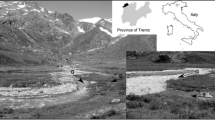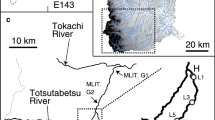Abstract
The structural changes induced by a small (0.015 km3) eutrophic hydropower impoundment, located in the middle Río Duratón (northern Spain, Duero basin), on the downstream hydropsychid guild were studied by comparing physicochemical and biological characteristics of an upstream site with those of three downstream stations placed 0.2, 2.5 and 7.6 km below the dam. Species richness, species diversity and concentration of dominance were depressed downstream from the impoundment. Total biomass and density were also depressed at the station immediately below the dam. However, total density and biomass values were higher at sites further downstream than at the upstream reference site, presumably due to improved food supply and more available habitat. Abundances of Cheumatopsyche lepida, Hydropsyche sp. and H. pellucidula decreased significantly or completely disappeared at downstream sites. On the contrary, abundances of H. siltalai, H. exocellata and H. bulbifera increased downstream except at the station just below the dam. H. lobata was present at low densities at all sampling sites. H. pellucidula was the dominant species upstream, whereas H. siltalai became dominant downstream. The size structure of H. bulbifera, H. exocellata and H. siltalai experienced a modification below the impoundment as a probable consequence of the reduction in the number of competing hydropsychid species. It is concluded that the main physicochemical factors involved in the spatial variation of hydropsychid species were dissolved oxygen deficit and short-term flow fluctuations.
Similar content being viewed by others
References
A.P.H.A., 1980. Standard Methods for the Examination of Water and Wastewater, 15th edn. APHA-AWWA-WPCF, Washington, DC, 1134 pp.
Armitage, P. D., 1984. Environmental changes induced by stream regulation and their effect in lotic macroinvertebrate communities. In A. Lillehammer & S. J. Saltveit (eds), Regulated Rivers, Universitetsforlaget, Oslo: 139–165.
Arthur, W., 1987. The Niche in Competition and Evolution. John Wiley & Sons, Chichester and New York, 175 pp.
Becker, G., 1987. Net-building behaviour, tolerance and development of two caddisfly species from the river Rhine (Hydropsyche contubernalis and H. pellucidula) in relation to the oxygen content. Oecologia 73: 242–250.
Boon, P. J., 1979. Studies on the spatial and temporal distribution of larval Hydropsychidae in the North Tyne river system (Northern England). Arch. Hydrobiol. 85: 336–359.
Boon, P. J., 1987. The influence of Kileder Water on trichopteran (caddisfly) populations in the River North Tyne (Northern England). Regulated Rivers: Research & Management 1: 95–109.
Brooker, M. P. & D. L. Morris, 1980. A survey of the macroinvertebrate riffle fauna of the rivers Ystwyth and Rheidol, Wales. Freshwat. Biol. 10: 459–474.
Camargo, J. A., 1989. Estudio ecotoxicológico del impacto ambiental generado por una regulatión de caudales y un vertido de flúor, sobre las comunidades de animales acuaticos del Río Duratón. Doctoral Dissertation, Madrid Autonomous University, Spain, 398 pp.
Camargo, J. A., 1990. The alteration in informative weights of biological species as an ecological indicator of environmental impacts. In Proc. 1st Int. Symposium Ecological Indicators, Fort Lauderdale (Florida, USA), October 16–19 1990; in press.
Hauer, F. R. & J. A. Stanford, 1982. Ecology and life histories of three net-spinning caddisfly species (Hydropsychidae: Hydropsyche) in the Flathead River, Montana. Freshwat. Invert. Biol. 1: 18–29.
Hemphill, N., 1988. Competition between two stream dwelling filter-feeders, Hydropsyche oslari and Simulium virgatum. Oecologia 77: 73–80.
Hildrew, A. G. & J. M. Edington, 1979. Factors facilitating the coexistence of hydropsychid caddis larvae (Trichoptera) in the same river system. J. anim. Ecol. 48: 557–576.
Lapchin, L. & A. Neveu, 1979. Ecologie des principaux invertebrates filtreurs de la basse nivelle (Pyrenees-Atlantiques). II- Hydropsychidae (Trichoptera). Ann. Limnol. 15: 139–153.
Macfarlane, M. B. & T. F. Waters, 1982. Annual production by caddisflies and mayflies in a western Minnesota plains stream. Can. J. Fish. aquat. Sci. 39: 1628–1635.
Mackay, R. J. & T. F. Waters, 1986. Effects of small impoundments on hydropsychid caddisfly production in Valley Creek, Minnesota. Ecology 67: 1680–1686.
Matczak, T. Z. & R. J. Mackay, 1990. Territoriality in filter-feeding caddisfly larvae: laboratory experiments. J.N. Am. Benthol. Soc. 9: 26–34.
M.O.P.U., 1980. Resumen del reconocimiento limnologico de embalses. Centro de Publicaciones del Ministerio de Obras Publicas y Urbanismo (MOPU), Madrid, Spain.
Muller, K., 1981. Effects of water regulation on the bottom fauna in two rapids in the River Dalalven. Fauna Norlandica 11: 1–20.
Nebeker, A. V., 1971. Effect of high winter water temperatures on adult emergence of aquatic insects. Wat. Res. 5: 777–783.
Parker, C. R. & J. R. Jr. Voshell, 1983. Production of filter-feeding Trichoptera in an impoundment and a free-flowing river. Can. J. Zool. 61: 70–87.
Petersen, L. B. N. & R. C. Petersen, 1989. Aggressive behavior between competing hydropsychid species. Bull. N. Am. Benthol. Soc. 6: 117.
Petts, G. E., 1984. Impounded Rivers: Perspectives for Ecological Management. John Wiley and Sons, Chichester and New York, 326 pp.
Rodier, J., 1981. Análisis de las Aguas. Ediciones Omega, Barcelona, 1059 pp.
Root, R. B., 1967. The niche exploitation pattern of the blue-gray gnatchatcher. Ecol. Monogr. 37: 317–350.
Sokal, R. R. & F. J. Rohlf, 1981. Biometry. W. H. Freeman and Co., San Francisco, 776 pp.
Troelstrup, N. H. Jr. & G. L. Hergenrader, 1990. Effect of hydropower peaking flow fluctuations on community structure and feeding guilds of invertebrates colonizing artificial substrates in a large impounded river. Hydrobiologia 199: 217–228.
Ward, J. V., 1982. Ecological aspects of streams regulation: responses in downstream lotic reaches. Wat. Pollut. Mgmt Rev. 2: 1–26.
Ward, J. V., 1985. Thermal characteristics of running waters. Hydrobiologia 125: 31–46.
Ward, J. V., 1987. Trichoptera of regulated Rocky Mountain streams. Proc. 5th Int. Symposium Trichoptera, Dr W. Junk Publishers, Dordrecht, The Netherlands; 375–380.
Ward, J. V. & J. A. Stanford, 1979. The Ecology of Regulated Streams. Plenum Press, New York, 398 pp.
Wiggins, G. B., 1984. Trichoptera. In R. W. Merrit & K. W. Cummins (eds), An Introduction to the Aquatic Insects of North America, Kendall/Hunt Publishing Company, Dubuque: 271–310.
Author information
Authors and Affiliations
Rights and permissions
About this article
Cite this article
Camargo, J.A. Changes in a hydropsychid guild downstream from a eutrophic impoundment. Hydrobiologia 239, 25–32 (1992). https://doi.org/10.1007/BF00027526
Received:
Revised:
Accepted:
Issue Date:
DOI: https://doi.org/10.1007/BF00027526




